Management Accounting Solutions: Detailed Financial Analysis
VerifiedAdded on 2021/04/24
|16
|3081
|23
Homework Assignment
AI Summary
This document provides comprehensive solutions to management accounting problems P3, P4, and P5. The solution to P3 includes income statements under both absorption and marginal costing methods, analyzing sales, cost of goods sold, and various overheads over three years. P4 delves into budgeting, explaining its purpose in planning and performance measurement, along with the advantages and disadvantages of budgeting, variance analysis, and ratio analysis. P5 explores the application of management accounting systems, such as cost accounting, inventory management, and job costing, in addressing financial problems within business organizations. The document offers a detailed financial analysis, including the use of management accounting systems for responding to financial problems in business organizations.

1
Management Accounting
Management Accounting
Paraphrase This Document
Need a fresh take? Get an instant paraphrase of this document with our AI Paraphraser
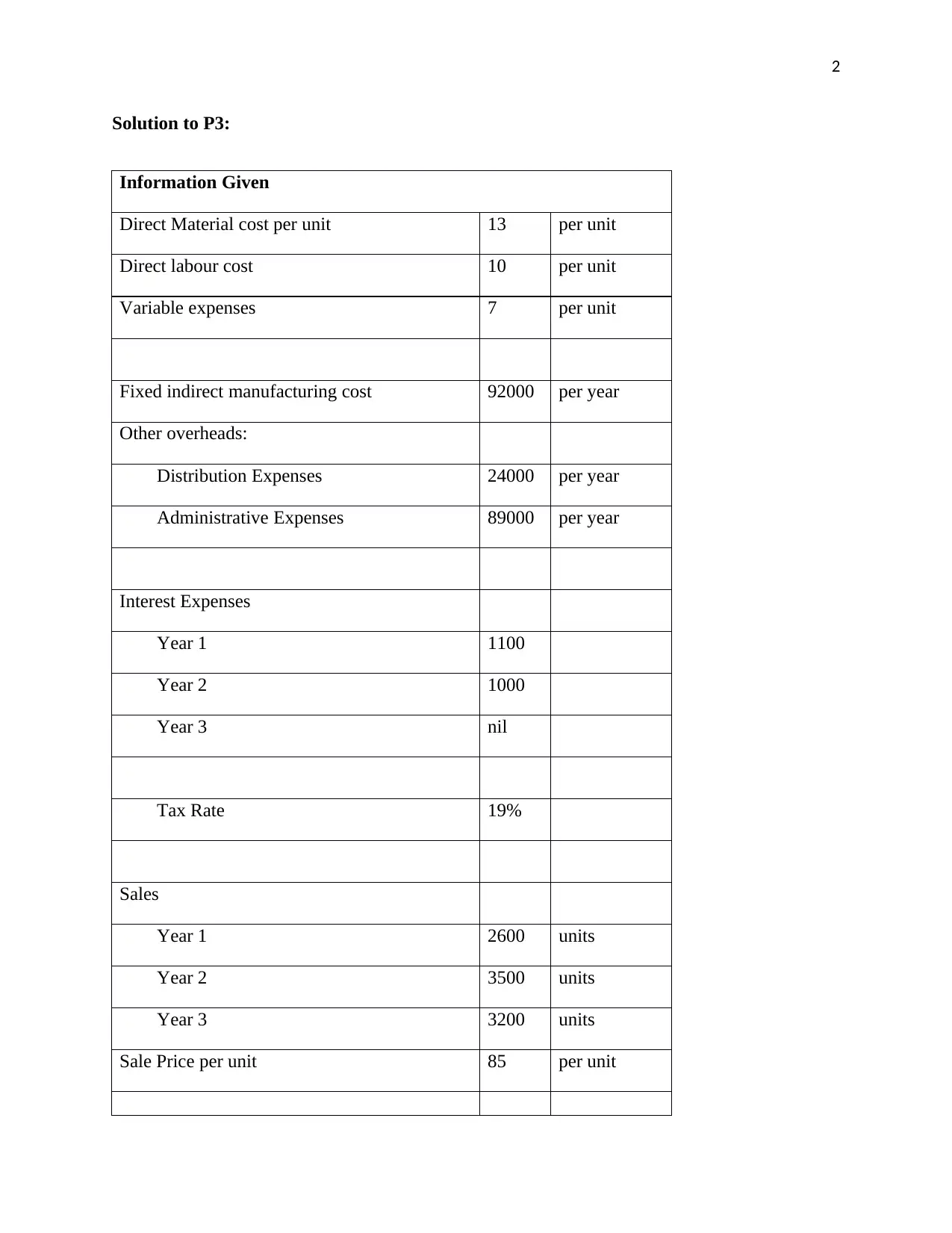
2
Solution to P3:
Information Given
Direct Material cost per unit 13 per unit
Direct labour cost 10 per unit
Variable expenses 7 per unit
Fixed indirect manufacturing cost 92000 per year
Other overheads:
Distribution Expenses 24000 per year
Administrative Expenses 89000 per year
Interest Expenses
Year 1 1100
Year 2 1000
Year 3 nil
Tax Rate 19%
Sales
Year 1 2600 units
Year 2 3500 units
Year 3 3200 units
Sale Price per unit 85 per unit
Solution to P3:
Information Given
Direct Material cost per unit 13 per unit
Direct labour cost 10 per unit
Variable expenses 7 per unit
Fixed indirect manufacturing cost 92000 per year
Other overheads:
Distribution Expenses 24000 per year
Administrative Expenses 89000 per year
Interest Expenses
Year 1 1100
Year 2 1000
Year 3 nil
Tax Rate 19%
Sales
Year 1 2600 units
Year 2 3500 units
Year 3 3200 units
Sale Price per unit 85 per unit
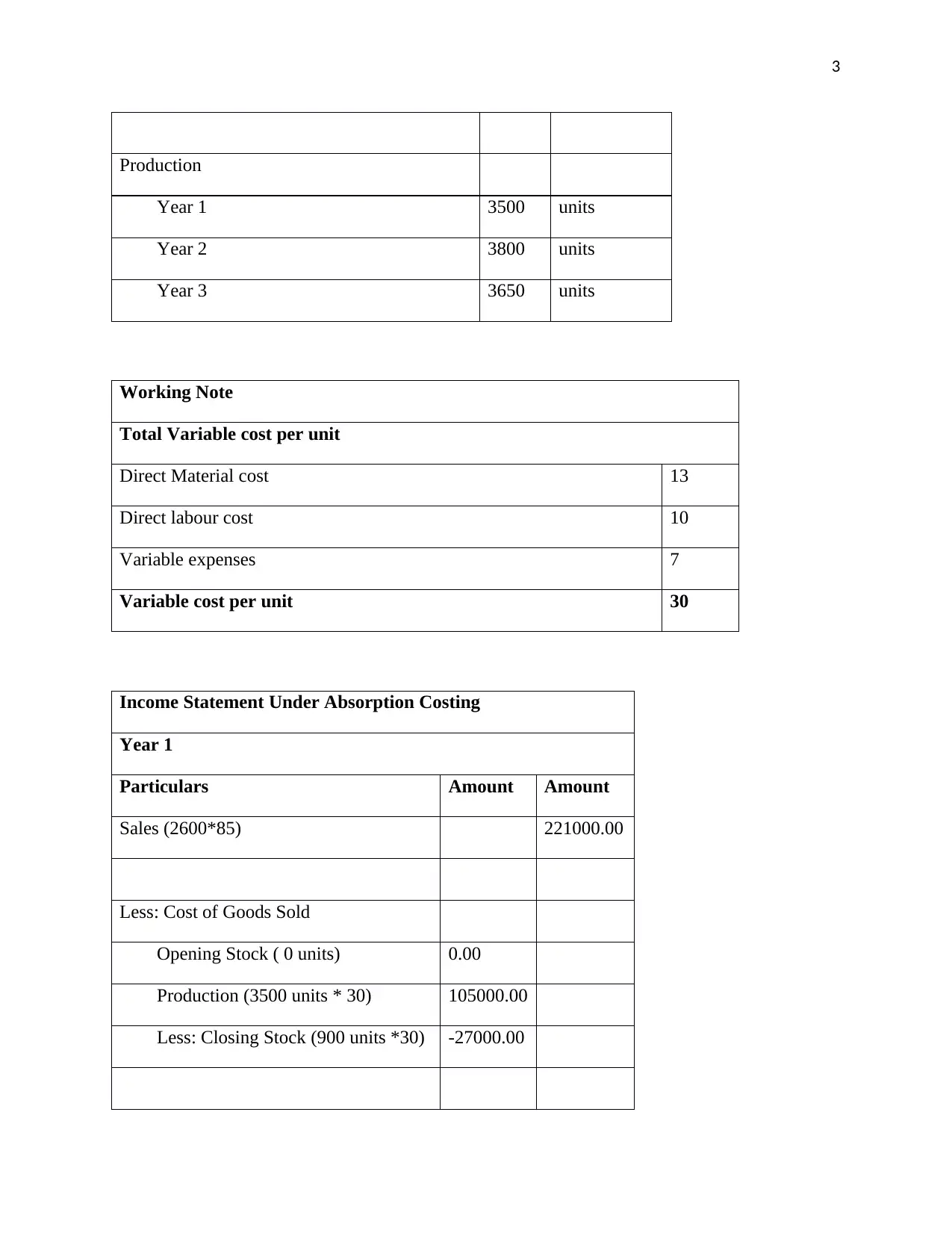
3
Production
Year 1 3500 units
Year 2 3800 units
Year 3 3650 units
Working Note
Total Variable cost per unit
Direct Material cost 13
Direct labour cost 10
Variable expenses 7
Variable cost per unit 30
Income Statement Under Absorption Costing
Year 1
Particulars Amount Amount
Sales (2600*85) 221000.00
Less: Cost of Goods Sold
Opening Stock ( 0 units) 0.00
Production (3500 units * 30) 105000.00
Less: Closing Stock (900 units *30) -27000.00
Production
Year 1 3500 units
Year 2 3800 units
Year 3 3650 units
Working Note
Total Variable cost per unit
Direct Material cost 13
Direct labour cost 10
Variable expenses 7
Variable cost per unit 30
Income Statement Under Absorption Costing
Year 1
Particulars Amount Amount
Sales (2600*85) 221000.00
Less: Cost of Goods Sold
Opening Stock ( 0 units) 0.00
Production (3500 units * 30) 105000.00
Less: Closing Stock (900 units *30) -27000.00
⊘ This is a preview!⊘
Do you want full access?
Subscribe today to unlock all pages.

Trusted by 1+ million students worldwide
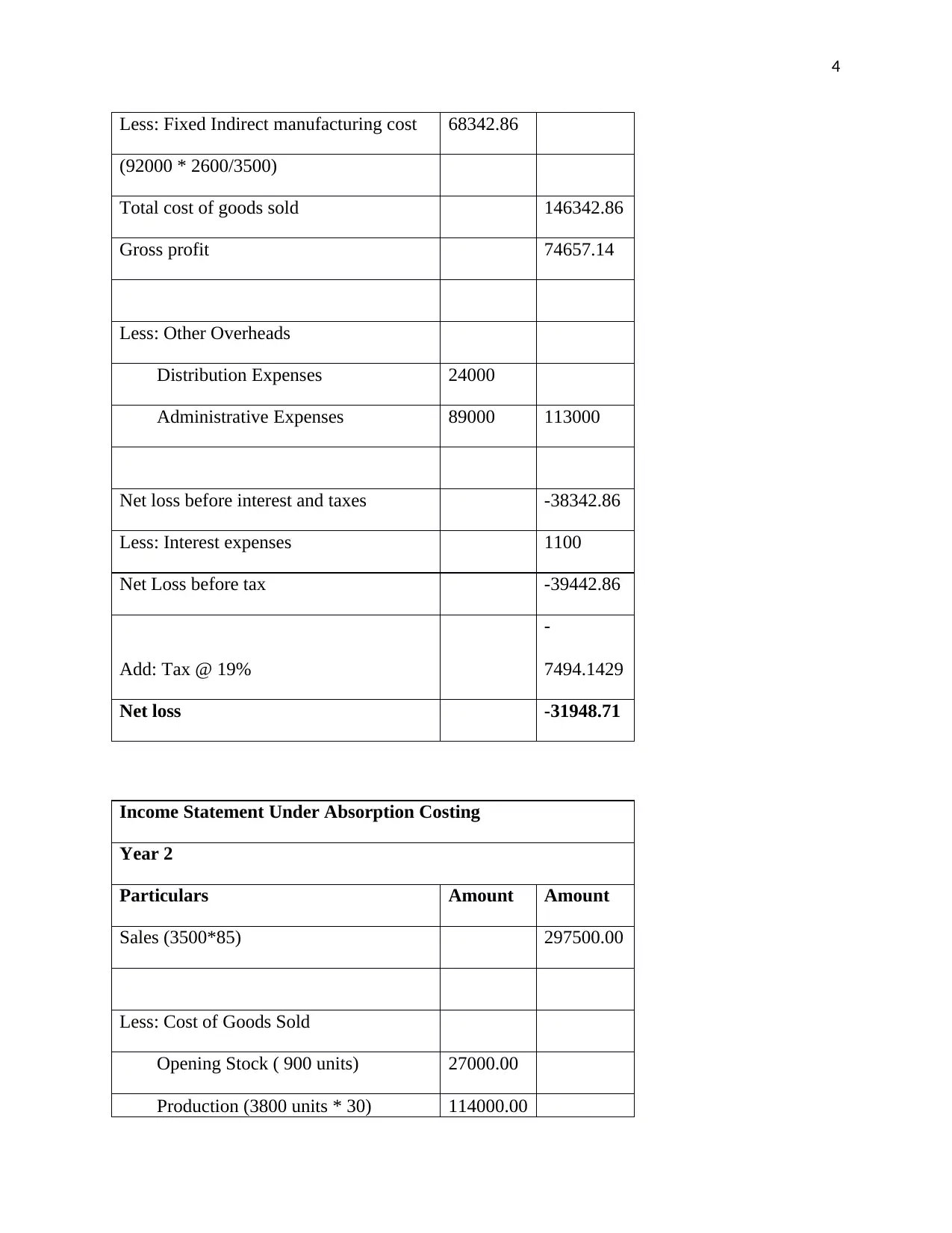
4
Less: Fixed Indirect manufacturing cost 68342.86
(92000 * 2600/3500)
Total cost of goods sold 146342.86
Gross profit 74657.14
Less: Other Overheads
Distribution Expenses 24000
Administrative Expenses 89000 113000
Net loss before interest and taxes -38342.86
Less: Interest expenses 1100
Net Loss before tax -39442.86
Add: Tax @ 19%
-
7494.1429
Net loss -31948.71
Income Statement Under Absorption Costing
Year 2
Particulars Amount Amount
Sales (3500*85) 297500.00
Less: Cost of Goods Sold
Opening Stock ( 900 units) 27000.00
Production (3800 units * 30) 114000.00
Less: Fixed Indirect manufacturing cost 68342.86
(92000 * 2600/3500)
Total cost of goods sold 146342.86
Gross profit 74657.14
Less: Other Overheads
Distribution Expenses 24000
Administrative Expenses 89000 113000
Net loss before interest and taxes -38342.86
Less: Interest expenses 1100
Net Loss before tax -39442.86
Add: Tax @ 19%
-
7494.1429
Net loss -31948.71
Income Statement Under Absorption Costing
Year 2
Particulars Amount Amount
Sales (3500*85) 297500.00
Less: Cost of Goods Sold
Opening Stock ( 900 units) 27000.00
Production (3800 units * 30) 114000.00
Paraphrase This Document
Need a fresh take? Get an instant paraphrase of this document with our AI Paraphraser

5
Less: Closing Stock (1200 units
*30) -36000.00
Less: Fixed Indirect manufacturing cost
Opening (900/3500) *92000 23657.14
Production (2600/3800)*92000 62947.37
Total cost of goods sold 191604.51
Gross profit 105895.49
Less: Other Overheads
Distribution Expenses 24000
Administrative Expenses 89000 113000
Net loss before interest and taxes -7104.51
Less: Interest expenses 1000
Net Loss before tax -8104.51
Add: Tax @ 19%
-
1539.8571
Net loss -6564.65
Income Statement Under Absorption Costing
Year 3
Less: Closing Stock (1200 units
*30) -36000.00
Less: Fixed Indirect manufacturing cost
Opening (900/3500) *92000 23657.14
Production (2600/3800)*92000 62947.37
Total cost of goods sold 191604.51
Gross profit 105895.49
Less: Other Overheads
Distribution Expenses 24000
Administrative Expenses 89000 113000
Net loss before interest and taxes -7104.51
Less: Interest expenses 1000
Net Loss before tax -8104.51
Add: Tax @ 19%
-
1539.8571
Net loss -6564.65
Income Statement Under Absorption Costing
Year 3
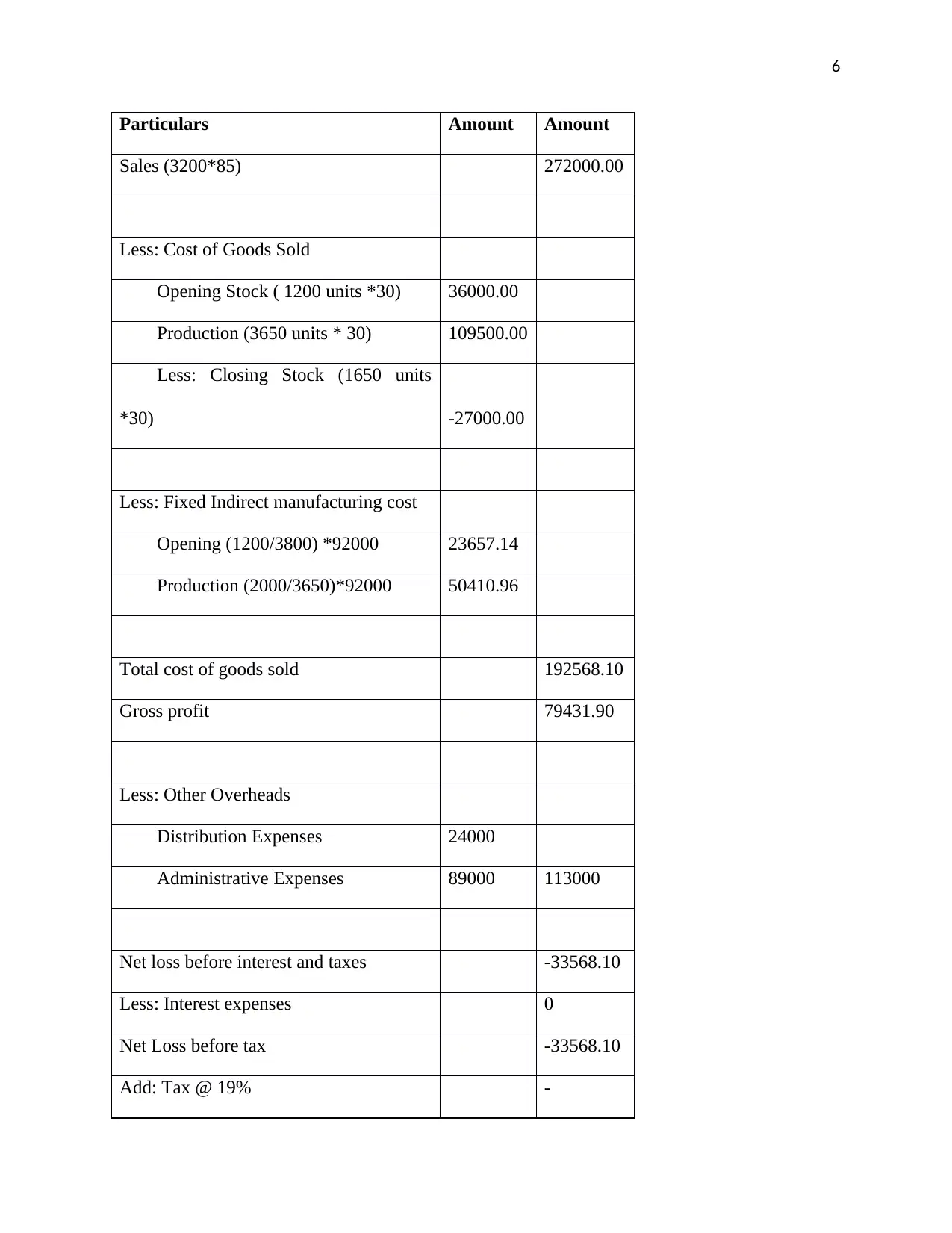
6
Particulars Amount Amount
Sales (3200*85) 272000.00
Less: Cost of Goods Sold
Opening Stock ( 1200 units *30) 36000.00
Production (3650 units * 30) 109500.00
Less: Closing Stock (1650 units
*30) -27000.00
Less: Fixed Indirect manufacturing cost
Opening (1200/3800) *92000 23657.14
Production (2000/3650)*92000 50410.96
Total cost of goods sold 192568.10
Gross profit 79431.90
Less: Other Overheads
Distribution Expenses 24000
Administrative Expenses 89000 113000
Net loss before interest and taxes -33568.10
Less: Interest expenses 0
Net Loss before tax -33568.10
Add: Tax @ 19% -
Particulars Amount Amount
Sales (3200*85) 272000.00
Less: Cost of Goods Sold
Opening Stock ( 1200 units *30) 36000.00
Production (3650 units * 30) 109500.00
Less: Closing Stock (1650 units
*30) -27000.00
Less: Fixed Indirect manufacturing cost
Opening (1200/3800) *92000 23657.14
Production (2000/3650)*92000 50410.96
Total cost of goods sold 192568.10
Gross profit 79431.90
Less: Other Overheads
Distribution Expenses 24000
Administrative Expenses 89000 113000
Net loss before interest and taxes -33568.10
Less: Interest expenses 0
Net Loss before tax -33568.10
Add: Tax @ 19% -
⊘ This is a preview!⊘
Do you want full access?
Subscribe today to unlock all pages.

Trusted by 1+ million students worldwide
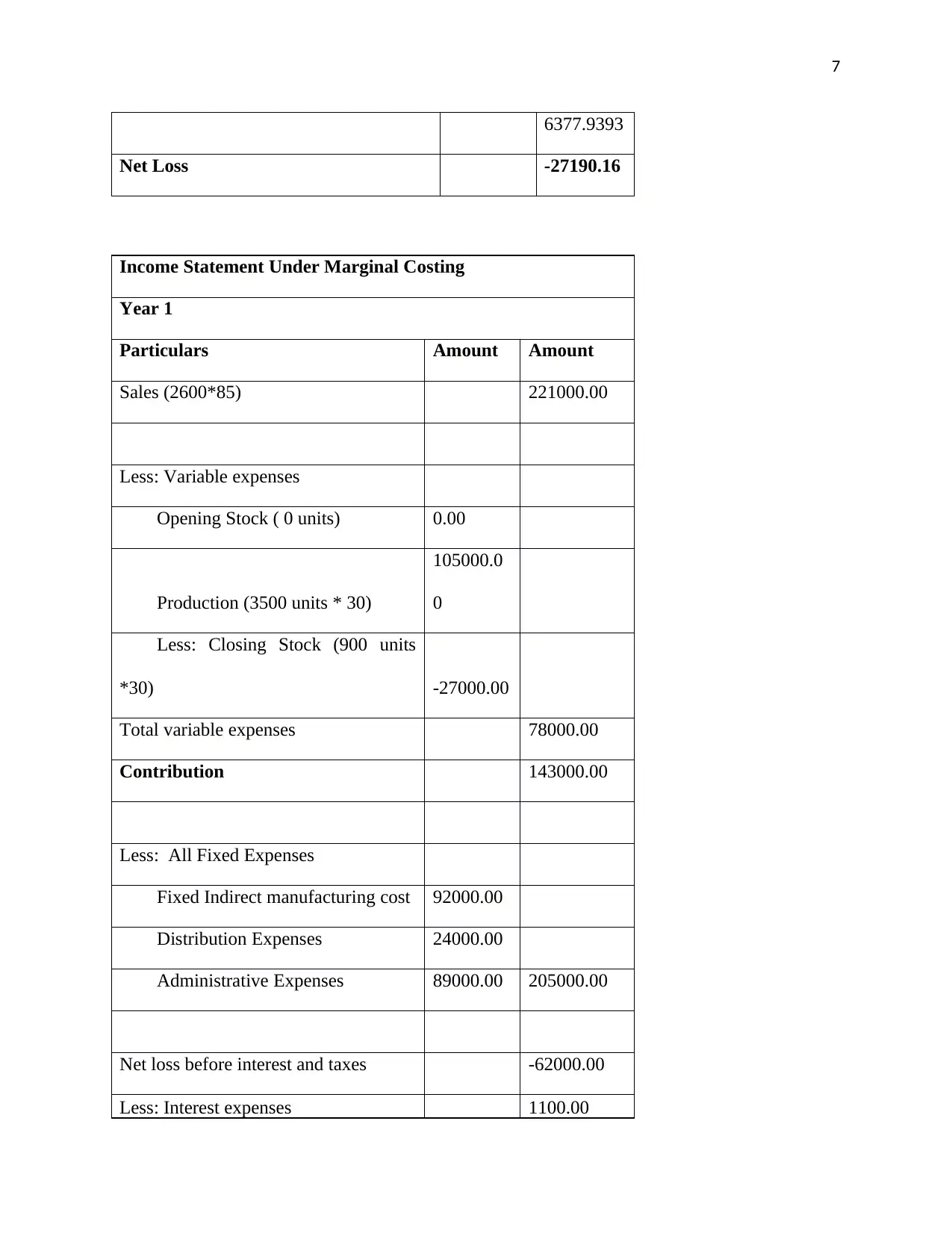
7
6377.9393
Net Loss -27190.16
Income Statement Under Marginal Costing
Year 1
Particulars Amount Amount
Sales (2600*85) 221000.00
Less: Variable expenses
Opening Stock ( 0 units) 0.00
Production (3500 units * 30)
105000.0
0
Less: Closing Stock (900 units
*30) -27000.00
Total variable expenses 78000.00
Contribution 143000.00
Less: All Fixed Expenses
Fixed Indirect manufacturing cost 92000.00
Distribution Expenses 24000.00
Administrative Expenses 89000.00 205000.00
Net loss before interest and taxes -62000.00
Less: Interest expenses 1100.00
6377.9393
Net Loss -27190.16
Income Statement Under Marginal Costing
Year 1
Particulars Amount Amount
Sales (2600*85) 221000.00
Less: Variable expenses
Opening Stock ( 0 units) 0.00
Production (3500 units * 30)
105000.0
0
Less: Closing Stock (900 units
*30) -27000.00
Total variable expenses 78000.00
Contribution 143000.00
Less: All Fixed Expenses
Fixed Indirect manufacturing cost 92000.00
Distribution Expenses 24000.00
Administrative Expenses 89000.00 205000.00
Net loss before interest and taxes -62000.00
Less: Interest expenses 1100.00
Paraphrase This Document
Need a fresh take? Get an instant paraphrase of this document with our AI Paraphraser
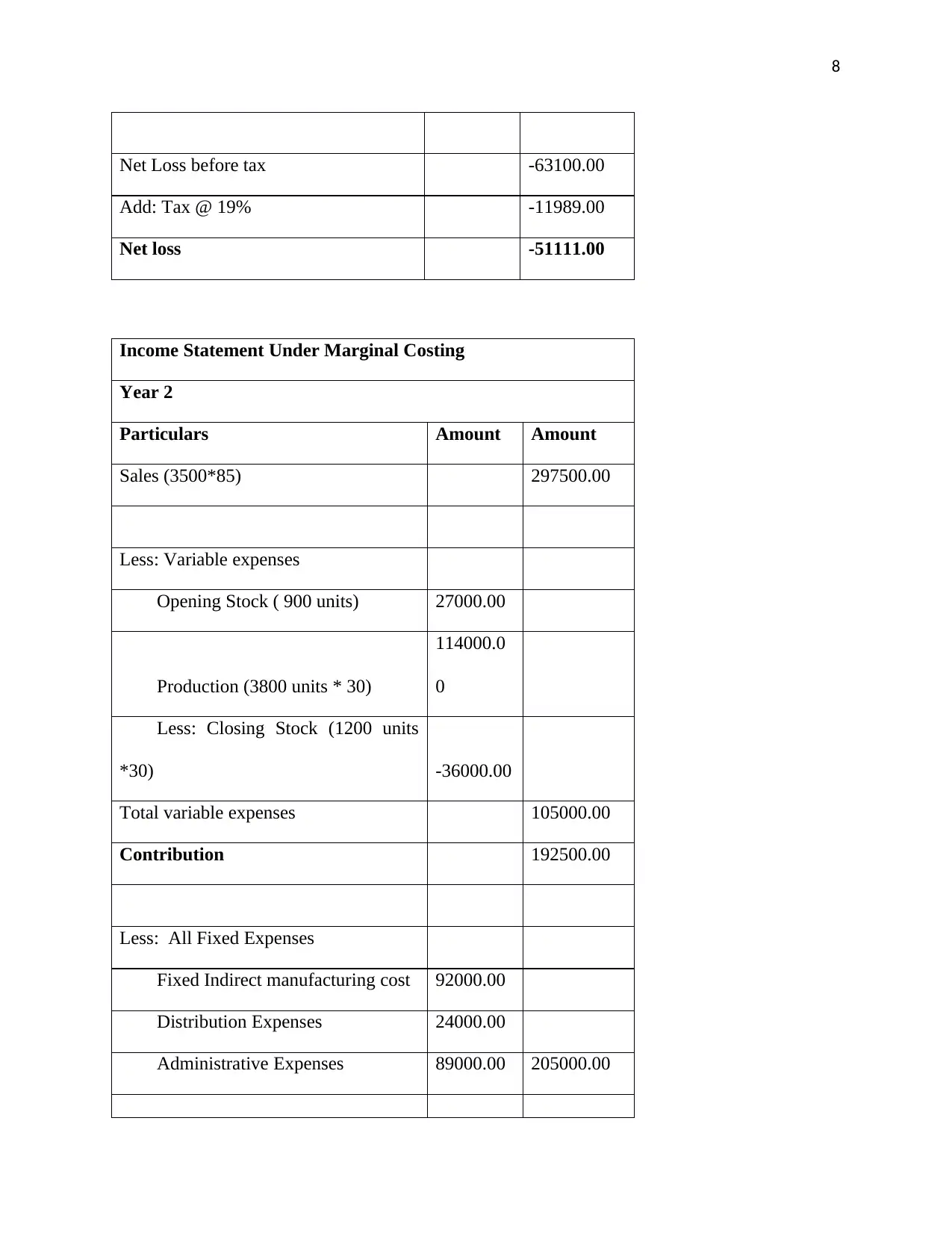
8
Net Loss before tax -63100.00
Add: Tax @ 19% -11989.00
Net loss -51111.00
Income Statement Under Marginal Costing
Year 2
Particulars Amount Amount
Sales (3500*85) 297500.00
Less: Variable expenses
Opening Stock ( 900 units) 27000.00
Production (3800 units * 30)
114000.0
0
Less: Closing Stock (1200 units
*30) -36000.00
Total variable expenses 105000.00
Contribution 192500.00
Less: All Fixed Expenses
Fixed Indirect manufacturing cost 92000.00
Distribution Expenses 24000.00
Administrative Expenses 89000.00 205000.00
Net Loss before tax -63100.00
Add: Tax @ 19% -11989.00
Net loss -51111.00
Income Statement Under Marginal Costing
Year 2
Particulars Amount Amount
Sales (3500*85) 297500.00
Less: Variable expenses
Opening Stock ( 900 units) 27000.00
Production (3800 units * 30)
114000.0
0
Less: Closing Stock (1200 units
*30) -36000.00
Total variable expenses 105000.00
Contribution 192500.00
Less: All Fixed Expenses
Fixed Indirect manufacturing cost 92000.00
Distribution Expenses 24000.00
Administrative Expenses 89000.00 205000.00

9
Net loss before interest and taxes -12500.00
Less: Interest expenses 1000.00
Net Loss before tax -13500.00
Add: Tax @ 19% -2565.00
Net loss -10935.00
Income Statement Under Marginal Costing
Year 3
Particulars Amount Amount
Sales (3200*85) 272000.00
Less: Variable expenses
Opening Stock ( 1200 units) 36000.00
Production (3650 units * 30)
109500.0
0
Less: Closing Stock (1650 units
*30) -49500.00
Total variable expenses 96000.00
Contribution 176000.00
Less: All Fixed Expenses
Fixed Indirect manufacturing cost 92000.00
Distribution Expenses 24000.00
Net loss before interest and taxes -12500.00
Less: Interest expenses 1000.00
Net Loss before tax -13500.00
Add: Tax @ 19% -2565.00
Net loss -10935.00
Income Statement Under Marginal Costing
Year 3
Particulars Amount Amount
Sales (3200*85) 272000.00
Less: Variable expenses
Opening Stock ( 1200 units) 36000.00
Production (3650 units * 30)
109500.0
0
Less: Closing Stock (1650 units
*30) -49500.00
Total variable expenses 96000.00
Contribution 176000.00
Less: All Fixed Expenses
Fixed Indirect manufacturing cost 92000.00
Distribution Expenses 24000.00
⊘ This is a preview!⊘
Do you want full access?
Subscribe today to unlock all pages.

Trusted by 1+ million students worldwide
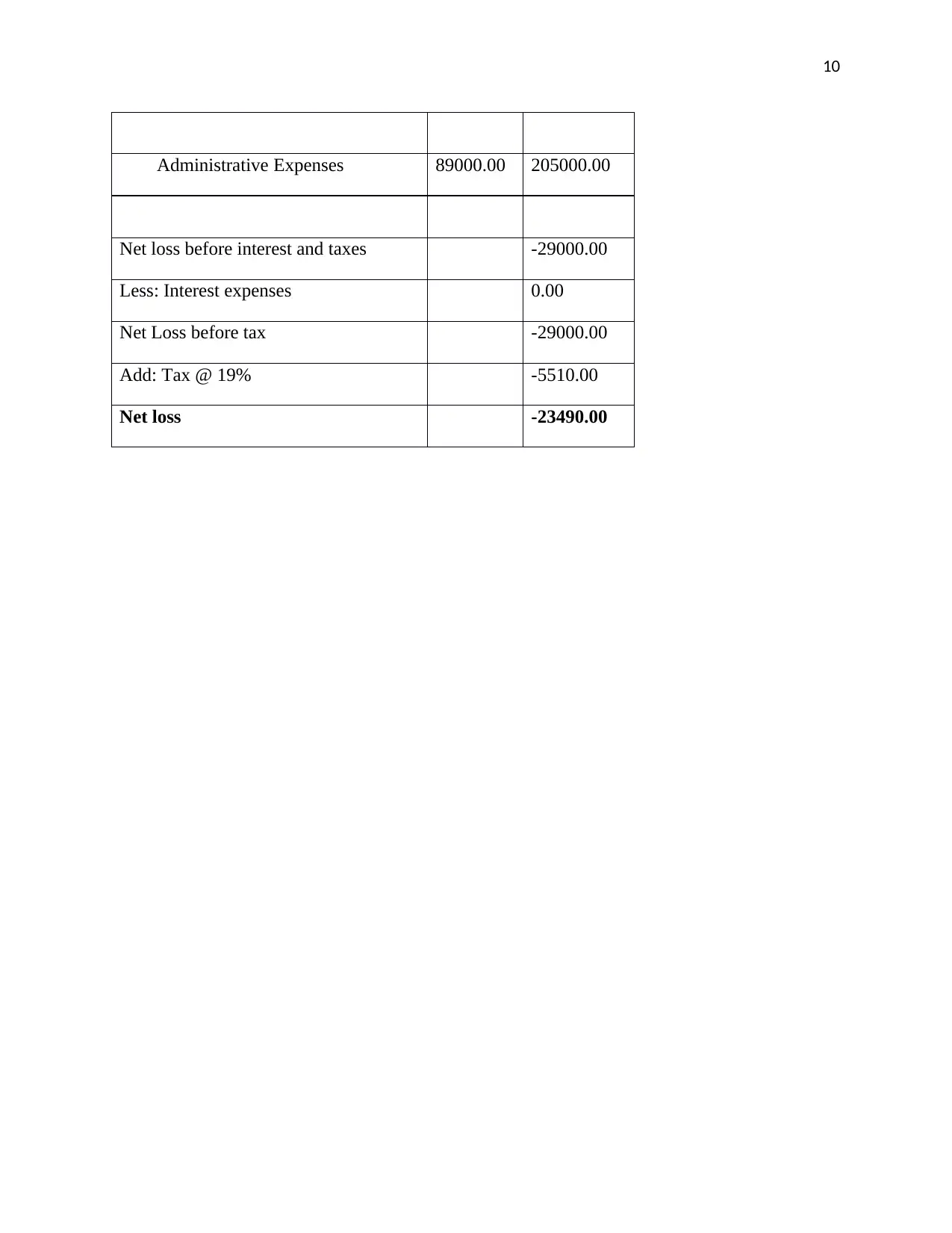
10
Administrative Expenses 89000.00 205000.00
Net loss before interest and taxes -29000.00
Less: Interest expenses 0.00
Net Loss before tax -29000.00
Add: Tax @ 19% -5510.00
Net loss -23490.00
Administrative Expenses 89000.00 205000.00
Net loss before interest and taxes -29000.00
Less: Interest expenses 0.00
Net Loss before tax -29000.00
Add: Tax @ 19% -5510.00
Net loss -23490.00
Paraphrase This Document
Need a fresh take? Get an instant paraphrase of this document with our AI Paraphraser
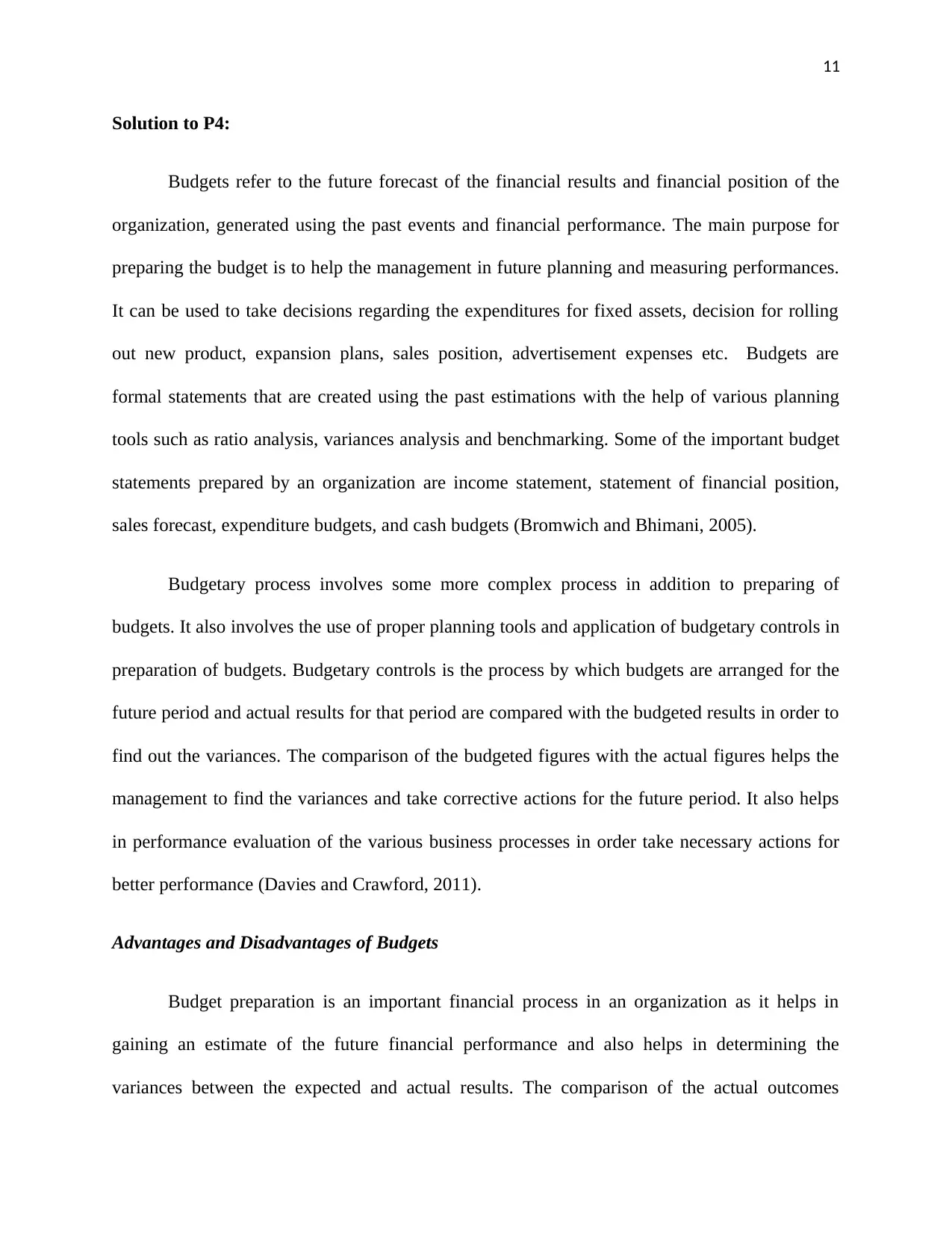
11
Solution to P4:
Budgets refer to the future forecast of the financial results and financial position of the
organization, generated using the past events and financial performance. The main purpose for
preparing the budget is to help the management in future planning and measuring performances.
It can be used to take decisions regarding the expenditures for fixed assets, decision for rolling
out new product, expansion plans, sales position, advertisement expenses etc. Budgets are
formal statements that are created using the past estimations with the help of various planning
tools such as ratio analysis, variances analysis and benchmarking. Some of the important budget
statements prepared by an organization are income statement, statement of financial position,
sales forecast, expenditure budgets, and cash budgets (Bromwich and Bhimani, 2005).
Budgetary process involves some more complex process in addition to preparing of
budgets. It also involves the use of proper planning tools and application of budgetary controls in
preparation of budgets. Budgetary controls is the process by which budgets are arranged for the
future period and actual results for that period are compared with the budgeted results in order to
find out the variances. The comparison of the budgeted figures with the actual figures helps the
management to find the variances and take corrective actions for the future period. It also helps
in performance evaluation of the various business processes in order take necessary actions for
better performance (Davies and Crawford, 2011).
Advantages and Disadvantages of Budgets
Budget preparation is an important financial process in an organization as it helps in
gaining an estimate of the future financial performance and also helps in determining the
variances between the expected and actual results. The comparison of the actual outcomes
Solution to P4:
Budgets refer to the future forecast of the financial results and financial position of the
organization, generated using the past events and financial performance. The main purpose for
preparing the budget is to help the management in future planning and measuring performances.
It can be used to take decisions regarding the expenditures for fixed assets, decision for rolling
out new product, expansion plans, sales position, advertisement expenses etc. Budgets are
formal statements that are created using the past estimations with the help of various planning
tools such as ratio analysis, variances analysis and benchmarking. Some of the important budget
statements prepared by an organization are income statement, statement of financial position,
sales forecast, expenditure budgets, and cash budgets (Bromwich and Bhimani, 2005).
Budgetary process involves some more complex process in addition to preparing of
budgets. It also involves the use of proper planning tools and application of budgetary controls in
preparation of budgets. Budgetary controls is the process by which budgets are arranged for the
future period and actual results for that period are compared with the budgeted results in order to
find out the variances. The comparison of the budgeted figures with the actual figures helps the
management to find the variances and take corrective actions for the future period. It also helps
in performance evaluation of the various business processes in order take necessary actions for
better performance (Davies and Crawford, 2011).
Advantages and Disadvantages of Budgets
Budget preparation is an important financial process in an organization as it helps in
gaining an estimate of the future financial performance and also helps in determining the
variances between the expected and actual results. The comparison of the actual outcomes
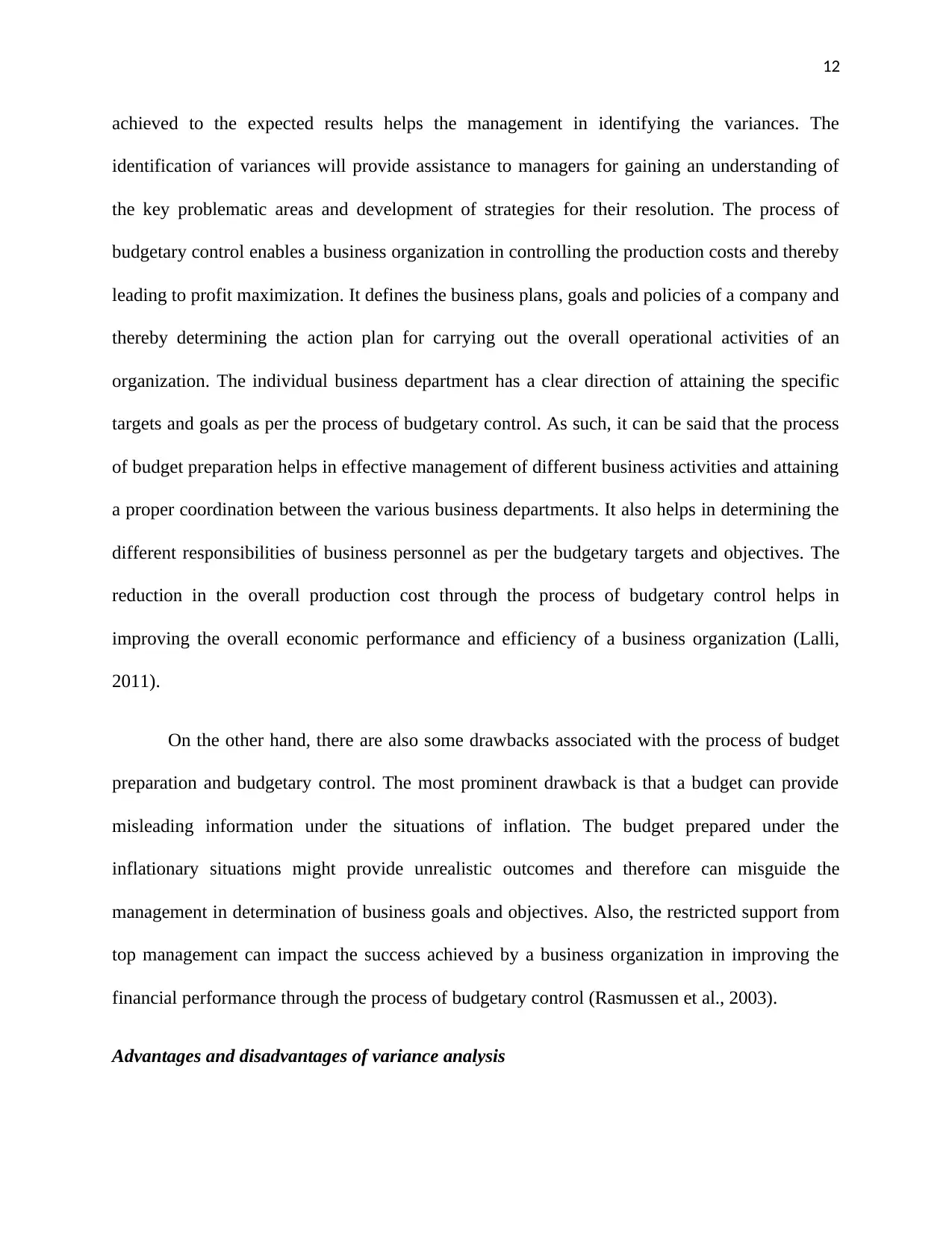
12
achieved to the expected results helps the management in identifying the variances. The
identification of variances will provide assistance to managers for gaining an understanding of
the key problematic areas and development of strategies for their resolution. The process of
budgetary control enables a business organization in controlling the production costs and thereby
leading to profit maximization. It defines the business plans, goals and policies of a company and
thereby determining the action plan for carrying out the overall operational activities of an
organization. The individual business department has a clear direction of attaining the specific
targets and goals as per the process of budgetary control. As such, it can be said that the process
of budget preparation helps in effective management of different business activities and attaining
a proper coordination between the various business departments. It also helps in determining the
different responsibilities of business personnel as per the budgetary targets and objectives. The
reduction in the overall production cost through the process of budgetary control helps in
improving the overall economic performance and efficiency of a business organization (Lalli,
2011).
On the other hand, there are also some drawbacks associated with the process of budget
preparation and budgetary control. The most prominent drawback is that a budget can provide
misleading information under the situations of inflation. The budget prepared under the
inflationary situations might provide unrealistic outcomes and therefore can misguide the
management in determination of business goals and objectives. Also, the restricted support from
top management can impact the success achieved by a business organization in improving the
financial performance through the process of budgetary control (Rasmussen et al., 2003).
Advantages and disadvantages of variance analysis
achieved to the expected results helps the management in identifying the variances. The
identification of variances will provide assistance to managers for gaining an understanding of
the key problematic areas and development of strategies for their resolution. The process of
budgetary control enables a business organization in controlling the production costs and thereby
leading to profit maximization. It defines the business plans, goals and policies of a company and
thereby determining the action plan for carrying out the overall operational activities of an
organization. The individual business department has a clear direction of attaining the specific
targets and goals as per the process of budgetary control. As such, it can be said that the process
of budget preparation helps in effective management of different business activities and attaining
a proper coordination between the various business departments. It also helps in determining the
different responsibilities of business personnel as per the budgetary targets and objectives. The
reduction in the overall production cost through the process of budgetary control helps in
improving the overall economic performance and efficiency of a business organization (Lalli,
2011).
On the other hand, there are also some drawbacks associated with the process of budget
preparation and budgetary control. The most prominent drawback is that a budget can provide
misleading information under the situations of inflation. The budget prepared under the
inflationary situations might provide unrealistic outcomes and therefore can misguide the
management in determination of business goals and objectives. Also, the restricted support from
top management can impact the success achieved by a business organization in improving the
financial performance through the process of budgetary control (Rasmussen et al., 2003).
Advantages and disadvantages of variance analysis
⊘ This is a preview!⊘
Do you want full access?
Subscribe today to unlock all pages.

Trusted by 1+ million students worldwide
1 out of 16
Related Documents
Your All-in-One AI-Powered Toolkit for Academic Success.
+13062052269
info@desklib.com
Available 24*7 on WhatsApp / Email
![[object Object]](/_next/static/media/star-bottom.7253800d.svg)
Unlock your academic potential
Copyright © 2020–2025 A2Z Services. All Rights Reserved. Developed and managed by ZUCOL.



